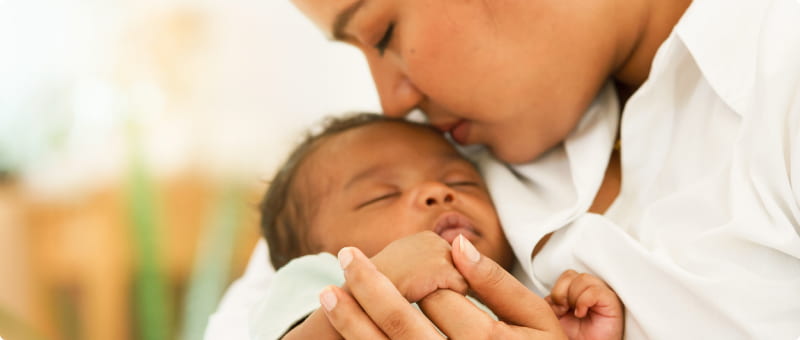How common are birth injuries in the United States?

Around 30,000 babies are born in the U.S. every year with some form of birth injury.
Here are some key birth injury statistics:
- Birth injuries are more common in males than females, often due to their size.
- 80% of birth injuries are considered moderate to severe, with only 20% classified as minor.
- Birth injuries account for 20% of the 20,000 infant deaths that occur in the U.S. every year.
- Birth injuries are the 4th-leading cause of death among infants.
Birth injury statistics on legal claims
Every year about 20,000 medical malpractice lawsuits are filed in the United States, and many of them are birth injury lawsuits.
The average medical malpractice payout for children under one month old is over $1 million.
However, it is important to remember that there is a wide range of birth injuries, some mild and others permanently disabling, so birth injury settlement amounts vary significantly.
If you suspect your child’s birth injury was the result of a medical mistake, we may be able to help.
Connect with our labor and delivery nurses in confidence to talk about what may have happened.
Birth injury statistics on causes
Birth injuries can happen for a number of reasons, and in some cases, the causes of birth injuries remain unknown.
A birth injury is usually caused by maternal or infant conditions but can have other causes as well, including medical negligence.
Maternal conditions
Severe maternal complications during labor occur in about 1% to 2% of all deliveries and can lead to birth injuries when they are not identified and managed.
- Advanced maternal age (over the age of 35), which occurs in 18% of pregnancies
- Delayed or prolonged labor, which occurs in about 8% of deliveries
- Gestational diabetes, which occurs in 7% to 8% of pregnancies
- Maternal infection, which occurs in about 4% of deliveries
- Obesity, which occurs in about 1 in every 4 pregnant women
- Placental abruption (detachment), which occurs in about 1 in every 100 pregnancies
Infant conditions
Infants can also be affected by a variety of conditions during labor and delivery that can lead to birth injuries when they are not diagnosed and properly managed.
- Breech (feet-first) positioning, which occurs in 3% to 4% of deliveries
- Fetal infection, which affects around 4% of deliveries
- Oxygen deprivation, which occurs to some degree in about 4 million deliveries each year
Other causes of birth injury
A birth injury can also result from a physical injury, usually to the baby’s head or shoulders, that occurs either during the birthing process or shortly after delivery.
Head and scalp injuries are the most common types of physical injuries to newborn babies, with scalp injuries accounting for 80% of all birth injuries.
When infants suffer a broken bone during childbirth, it is most likely to be a clavicle (collarbone) fracture, occurring in 0.2% to 4.5% of deliveries.
If you think your child’s birth injury could have been avoided, get a confidential case review now. There is no cost or obligation.
Statistics on birth injury risk factors
While any child can be born with a birth injury, some infants are more likely than others due to certain risk factors.
Some of these risk factors can be managed in the prenatal period, while others may be outside the control of the medical team.
Here are important birth injury statistics on risk factors.
Delivery complications
Delivery complications include failure to progress, fetal distress, excessive bleeding, and malpositioning of the baby in the birth canal.
Fetal distress (when a baby is not receiving enough oxygen during pregnancy or labor) is estimated to occur in 5% to 10% of deliveries.
Gestational diabetes
Gestational diabetes (occurring while the mother is carrying the child) affects 7% to 8% of all pregnancies in the U.S. each year.
Gestational diabetes can result in several health conditions in babies, including:
- High birth weight
- Low blood sugar
- Premature birth
- Type 2 diabetes later in life
Health of the baby
The infant can also be in poor health at the time of delivery, sometimes due to the mother passing an infection during vital periods of development.
Babies can also experience failed development or growth while still in the womb, making birth injury more likely.
Additionally, 3% of babies are born with birth defects, sometimes called congenital abnormalities, that can negatively affect their overall health and even be fatal in some instances.
Health of the mother
If the mother is in poor health, particularly if she has a viral or bacterial infection, the infant can be at risk for a birth injury.
According to the Centers for Disease Control and Prevention (CDC), 8% of women experience a urinary tract infection (UTI) during pregnancy.
UTIs during pregnancy can be very dangerous, leading to miscarriage, stillbirth, or preterm birth. They can also be passed to the infant as a life-threatening infection.
Labor induction
Around 20% to 40% of labor is induced, according to birth injury statistics from the American College of Obstetricians and Gynecologists (ACOG).
Labor induction can put an infant at risk for a birth injury, mainly because of certain medications, such as Pitocin.
Preeclampsia
Preeclampsia is a condition that occurs in 5% to 7% of all pregnancies and involves high blood pressure and proteins in a woman’s urine.
It is an extremely dangerous condition and one of the leading causes of death for women during pregnancy.
Position of the baby
A baby's position in the birth canal, especially breech position, can put them at a greater risk for a birth injury.
Around 3% to 4% of babies are in the breech position at the start of labor, often requiring a cesarean section (C-section) for the safety of both the mother and child.
Size of the baby
According to the CDC, 8% of babies are born underweight, and another 8% are born overweight.
Birth injury statistics by condition
There are many different types of birth injuries, ranging from mild to severe. In some instances, a child can even die from a birth injury.
Here are birth injury statistics for some of the various health conditions.
Cerebral palsy
Cerebral palsy (CP) is a group of movement disorders caused by brain damage or injury to the developing brain before, during, or after labor.
Between 8,000 and 10,000 babies are diagnosed with cerebral palsy every year in the U.S.
These are the 5 types of cerebral palsy:
- Spastic cerebral palsy accounts for 77% of cerebral palsy cases
- Athetoid (dyskinetic) CP affects about 2.6% of children with cerebral palsy
- Hypotonic CP makes up about 2.6% of cerebral palsy cases
- Ataxic CP represents about 2.4% cases
- Mixed CP makes up about 15.4% of all cases
Erb’s palsy
Erb’s palsy, also known as brachial plexus palsy or brachial plexus injury, is a nerve injury and resulting medical condition that occurs in about 1 in every 1,000 live births.
This condition is characterized by nerve damage and muscle weakness in the affected arm or shoulder. It is often the result of difficult labor.
- Assistive delivery tools such as forceps or vacuum extractors
- Baby’s shoulder caught behind the mother’s pelvis (shoulder dystocia)
- Breech (feet-first) position at the time of delivery
- High birth weight (fetal macrosomia)
- Multiple births (such as twins or triplets)
- Use of excessive force by the delivery team
Hypoxic-ischemic encephalopathy (HIE)
HIE is a severe type of brain damage that occurs when the infant’s brain is deprived of oxygen. It is estimated to occur in 1% to 2% of live births.
This condition, also known as birth asphyxia, is one of the leading causes of neonatal death and is much more common in countries with less advanced health care.
- High or low blood pressure in the mother
- Infection in mother or baby
- Problems with the placenta
- Umbilical cord problems
- Uterine rupture
Intrauterine Fetal Demise
Intrauterine fetal demise (IUFD or stillbirth) occurs when a baby dies any time at or after 20 weeks of pregnancy.
Despite stillbirth being the 5th-leading cause of death worldwide, it is estimated that less than 5% of stillbirths are reported.
Furthermore, 76% of stillbirths globally have an undetermined cause.
The rate of stillbirths has decreased steadily over the last few decades, as reported by the CDC, but there were still an estimated 21,000 fetal deaths in the U.S. in 2020.
Jaundice
Jaundice is quite common in childbirth, with nearly 60% of newborns experiencing the condition to some degree shortly after being born.
Jaundice occurs when an infant has high bilirubin levels. Bilirubin is a waste product related to red blood cells being broken down.
While it is a common condition, some babies are at a higher risk of developing jaundice.
- Incompatible blood types between mother and baby
- Liver malfunction
- Premature birth
- Viral or bacterial infection in mother or baby
Kernicterus
Kernicterus is a rare condition that results when a newborn has too high of a bilirubin concentration in their blood. It is often due to severe or untreated jaundice.
Kernicterus is a type of brain damage that can result in cerebral palsy, hearing and vision loss, or intellectual disabilities.
Because jaundice is usually treated, only about 1 in 44,000 newborns develop kernicterus.
Newborn brain damage
Newborn brain damage affects roughly 3 infants out of every 1,000 that reach full-term.
Brain damage in newborns can range from mild to severe and may be treatable depending on the severity of the condition.
- Caput succedaneum
- Hydrocephalus
- Hypoxic-ischemic encephalopathy (HIE)
- Intracranial hemorrhage
- Kernicterus
- Traumatic brain injury
Newborn cephalohematoma
Cephalohematoma is a somewhat common condition that is usually harmless and results from blood vessels rupturing on a baby's scalp.
Cephalohematoma occurs in roughly 2.5% of vaginal births. It increases to 10% of vaginal births when forceps or vacuum extraction is used.
- High birth weight
- Pregnancy involving multiples
- Prolonged or difficult vaginal delivery
- Use of epidural (pain-relieving spinal injection)
Spinal cord injuries
Children account for less than 5% of all spinal cord injuries, but the consequences of spinal cord injury in a child, especially an infant, can be devastating.
Most spinal cord injuries occur when the spine or neck is bent or compressed.
- Extreme back or neck pain
- Loss of bladder and bowel control
- Muscle weakness
- Numbness or tingling in the arms and fingers
- Partial or complete loss of movement below where the injury occurred
- Stiffness in the neck
- Trouble breathing
Birth injury statistics on co-occurring conditions
Infants who experience birth injuries often experience co-occurring conditions. The conditions could be present at birth or show up later in life.
For example, people with cerebral palsy often also experience:
- Intellectual disabilities: 45%
- Epilepsy: 25%
- Vision loss or impairment: 10%
- Autism: 7%
- Hearing loss or impairment: 5%
Erb's palsy also has co-occurring medical conditions, particularly a broken collarbone, which occurs in about 50% of Erb’s palsy cases.
Birth injury statistics on treatment options
Birth injuries can range from mild to severe. Some are also more treatable than others. Some mild cases of birth injuries can improve on their own with time.
Physical therapy, which involves exercises and physical activities designed to improve strength and combat muscle weakness, has been shown to increase an affected child’s mobility by up to 13%.
Erb’s palsy is a birth injury that has proven to be highly treatable, with nearly a 100% recovery rate in infants who begin treatment within a month of birth.
Using birth injury statistics to understand legal options
While birth injury statistics can seem alarming for new families, they can also serve as a reminder that you’re not alone.
If your child suffered from trauma at birth, understanding birth injury statistics can help pinpoint what may have happened.
If you suspect your child’s birth injury could have been prevented, we may be able to help. You could be able to access financial compensation to help your child live their best possible life.
Call Cerebral Palsy Guide 24/7 at (855) 220-1101 or get a free birth injury case review now.

